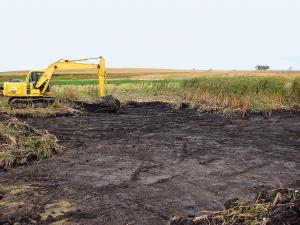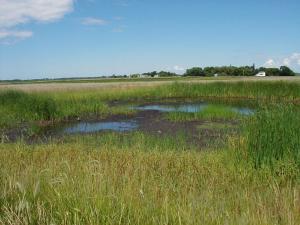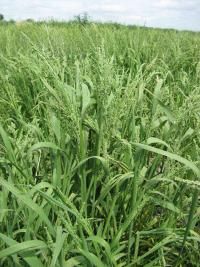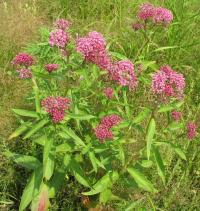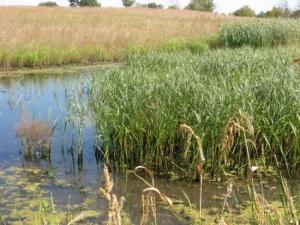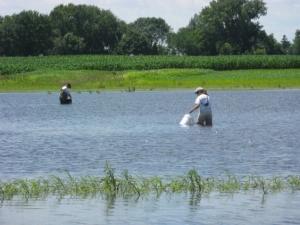What's Working for Conservation
Wetland Establishment
2018 Information
Thorough site preparation: There is often a tendency to rush site preparation for one reason or another (grant periods, the need for wetland credit, impatience), but this usually leads to trouble down the road. Time is needed to ensure that previously applied agricultural chemicals are not having unintended consequences, and that reed canary grass and other species will not overtake wetland seedlings (sometimes annuals such as smartweeds, barnyard grass, or bidens may need to settle down for a year before the seeding can be successful). (Dan Shaw, BWSR)
Final Seedbed Preparation: Final seedbed preparation is a topic that needs more discussion in restoration as it is an important step that often gets overlooked. Many projects are planted following soybeans. If any tilling is done it will be important to allow the soil to settle somewhat (rainfall would be beneficial) before seeding so that the tiny wetland seed is not buried too deep (around .5 cm. of soil can prevent germination of some species). The exception is native grasses and some forbs with larger seed that benefit from being a little deeper in the soil (around 1/8 to ¼ inch) but for the native cool-season grasses we’ve found that this isn’t essential, they mainly need good seed to soil contact. If the soil surface is relatively loose and soils do not need additional drying then additional tilling may not be needed and may only increase weed growth. If the soil surface is not tilled we sometimes roll sites following broadcast seeding, particularly if the soil surface is smooth to help prevent the tiny seed from blowing away. (Dan Shaw, BWSR)
Project Sequencing: For all wetland bank plans developed in Minnesota a full schedule of “expected” restoration activities including site preparation activities, construction, planting and management is required to be in restoration plans. In most cased wetlands are seeded in the fall after construction is completed to allow seed to be naturally stratified over winter and avoid problems with accessing wet sites in the spring. This sequence has worked well for most of our projects as long as flooding or flowing water have not been a problem with moving seed around in the spring.
A variety of factors have caused our wetland restoration project vegetation establishment to get off schedule including extreme weather, permitting and easement timelines, and construction contractor availability and timelines. As a result, flexibility in installation dates has been needed for several projects. We have started working this flexibility into project plans so we have a clear approach regardless of the seeding date. (Dan Shaw, BWSR)
Native Seedbank is still the first priority: Releasing the native seedbank (pdf) through scraping or herbicide application is still the first preference for projects, if a viable seedbank likely exists. This is hard to judge, and may take some time to understand the results (and if supplemental seeding would help).
Seed biology is important: Wetland seed comes in all shapes and sizes (most are very small), some float (tussock sedge, bur-reed, arrowhead, swamp milkweed, plantain), some sink (Torrey’s rush, woolgrass) and some float and then sink (sweet flag, bulrushes, spikerushes, rice cut grass, manna grass). Some germinate the first year (wetland grasses, bugleweed, mountain mint, Culver’s root), some the second (most sedges rushes and forbs), and some with thick seed coats, further down the road (bur-reed).
Planting the Right Seed at the Right Time: As a general rule we have found that forbs, sedges and cool-season grasses establish well with fall dormant seedings (generally after Oct.15) while warm season grasses establish best in later summer. For wetland restoration projects the fall seeding date works out well as it often follow construction activities and sites are still accessible with seeding equipment. We have started adding some extra warm season grass (around a 10% increase) into upland mixes when seeding in the fall as it often does not establish effectively in the spring, likely from herbivores eating the seed over winter and a general loss in germination of the seed. One other options for projects involved seeding the uplands in late spring or early summer followed by seeding the wetlands in the spring. Since as little as 0.5 cm of sediment (pdf) can keep most wetland seeds from germinating stabilizing uplands first can help prevent this problem. The one challenge with this approach is that equipment will likely need to drive over the uplands to conduct construction in the wetlands and this will require that soil is loosened where the vehicles traveled and that these areas are re-seeded in the fall. (Dan Shaw, BWSR)
Reseeding: Wetland seed is expensive, so it is best to get effective establishment from the beginning, but a variety of conditions such as extreme weather, herbivores, chemical carryover from agriculture, and the need for additional weed control can create problems with establishment in some portions of project sites. If these areas are around 100 square feet or larger (or are smaller but have a high likelihood of weed establishment) re-seeding may be needed. Around half of the projects that we work on require some additional seed during the establishment phase of projects. Our preference is to have a small crew collect seed from successfully established areas and spread this seed to aid establishment, this way we can maximize the use of seed that is coming up from the seedbank. (Dan Shaw, BWSR)
Scraping Reed Canary Grass: Reed canary grass is one of the most difficult challenges encountered when attempting to restore native vegetation in wetlands. Scraping is one method that is being used to deal with the species but results can vary depending on the methods used. We’ve found that it is important to investigate the depth of reed canary grass roots to determine the appropriate depth for scraping (they can vary depending on soils and hydrology conditions), it is common that they are ten inches deep but this may vary. It is also important that scraping is conducted in a way that will not mix reed canary grass rhizomes with the soil leading to re-establishment of the grass. We had one project where the grass was scraped into the ditch with a backhoe but it was not cleanly scraped into the wetland. It is important that experienced operators are using the equipment to effectively remove the reed canary grass and bulldozers seem to work the best. In some cases it is being removed in early winter after the frost reaches the right depth for removal so that the soil comes off in one layer. (Dan Shaw, BWSR)
When Cover Crops are Helpful: There is debate in the restoration community about whether cover crops are a good thing along with native mixes or not. Cover crops are included in state seed mixes with oats or winter wheat being included with the mixes. The concern with cover crops is that they will compete with the native species as they establish and this is a viable concern for wetland and upland plant communities. Cover crops can be helpful in helping to identify where flooding or other disturbances have disrupted a planting and if the cover crops are not coming in then there is a good chance that the native species will not do well either. Generally we think that cover crops are ok to have in mixes as long as they are not in larger amounts. Oats planted in early fall won’t get very large before dying with the first hard frost and won’t overwinter well when dormant seeded, so in the case of oats they will come up best when planted in the spring. Winter wheat is often used when stabilization on embankments is needed on projects when fall construction is completed. Winter wheat will green up again in the spring and can provide high competition for native species, so it should be used sparingly or be sprayed out in the spring before natives are seeded.
Establishing Deep Marsh Vegetation: Due to the high cost of the shallow marsh mix it may be desirable to plant the outer zones of the wet meadow (maybe a 30 foot band into the wet meadow) with the shallow marsh mix and then use a new “deep marsh” pilot mix that has been developed that has a higher percentage of species that has seed that sinks (to prevent seed from floating and moving to the edges of open water) in the deeper portions of the marsh. This mix is also less expensive. See pilot mixes at: http://www.bwsr.state.mn.us/native_vegetation/
Deep Marsh Establishment: Additional planning is needed for the deep marsh areas to aid establishment and help ensure that performance standards are met. A new pilot deep marsh mix has been developed as an option for these types of areas, it will work best for areas where water levels will increase progressively over time in deep marsh areas. The mix can be found at: http://www.bwsr.state.mn.us/native_vegetation/ under “pilot seed mixes”. If water levels will likely fill the basin quickly it will be a better strategy to focus more on installing plants to ensure establishment. From the plan it looks like a shallow marsh seed mix will be used along the edge of open water and that four emergent species will be planted when water levels are drawn down. Some of these species will be able to spread into deeper water areas to aid establishment. If there are areas three feet deep or deeper it is recommended to add some submergent or floating leaf species. If submergent or floating leaf species are planned it is recommended to work with suppliers of plant materials to determine the best planting strategies for individual species.
Seed and Plant Sources for Wetland Restoration: It is recommended to use the seed specifications in BWSR’s Native Vegetation Establishment and Enhancement Guidelines (pdf) that promote the use of local sources to the extent possible to ensure local adaptation of seed and to help prevent the introduction of undesirable species such as Palmer Amaranth that was recently introduced into the state. Generally, seed sources within 150 miles of the site are recommended.
Vegetation Establishment Maintenance: For state funded projects we have been experimenting with the use of Imazapyr herbicide for controlling solid clumps of non-native cattails and reed canary grass. it has been effective is accomplishing good removal of solid areas of invasive species with less regrowth than seen with Glyphosate herbicides, however the down side of the chemical is that it can inhibit germination and prevent re-seeding for at least six months. (Dan Shaw, BWSR)
Wild Rice Establishment: The following are key considerations for wild rice establishment.
The first question to consider is if the site is suitable for wild rice. All of Minnesota is within the historic wild rice range, but not all sites are suitable for wild rice. Rice grows best in water depths ranging from ½ to 3 feet, though 1 ½ feet is considered ideal. Sites with flowing water, such as basins with inlets and outlets, are generally more productive than sites without surface flow. Basins without surface flow should have significant ground water movement. A soft muck bottom is ideal, but rice can grow well in other soft substrates including sand. Water chemistry should be fresh rather than saline.
If the particular site used to have wild rice, but doesn’t any longer, there is likely a habitat problem. That problem needs to be identified and fixed before planting. If the habitat conditions aren’t right, seeding rice will just be a waste of time and money. Once the habitat issue is resolved, wild rice will often come back on its own, as the seeds can remain viable in the substrate for decades, and seeding may not even be needed. The most likely suspect in these cases is excessive water levels.
Many folks think that wild rice seeds, like other food plants, should be planted in the spring. However, the best time to plant wild rice is in the fall. For germination to occur, wild rice seeds need to be kept wet and exposed to freezing conditions for 3-4 months. So the best planting method mimics the natural process: the seed should be harvested when ripe, in August or September during the ricing season, and then planted within a day or two in the selected basin. The grains can be simply tossed into the water by hand. Mixing the seeds with sediment to form “mud balls” is not necessary. Fully ripe seeds will sink to the bottom on their own. If wild rice will not be planted right away after harvest, the seeds will need to be kept wet; if they dry out, they won’t sprout. Placing the rice in a burlap sack or mesh bag and submerging in a tub of water is a common method to keep seeds viable. Seeding can be delayed until spring, but only if the grain is kept wet and exposed to near-freezing temperatures until planted.
Finding a source of seed geographically close to the planting site is the best approach for a couple of reasons. There are three taxa of wild rice documented in Minnesota: Zizania palustris var. palustris, Zizania palustris var. interior, and Zizania aquatica var. aquatica. The Zizania palustris varieties (northern wild rice) are found throughout most of the state, while Zizania aquatica (southern wild rice) is limited to southeast Minnesota. If you are trying to restore wild rice to a basin, using a local seed source will increase the odds that you are restoring the taxa of wild rice that was native to that site. A second reason is that the more local a source, the increased chance of success. For instance, rice seed from Becker County will likely grow better in Otter Tail County than rice seed from St. Louis County. However, getting seed from a nearby source is not always feasible. But the maximum distance allowed from the site to the seed source, per the DNR planting permit, is 200 miles.
Distance is not the only factor to consider. Long-time ricers see distinct differences between lake and river rice. If planting a lake site, stick with a lake-source seed, and make the same consideration for rivers.
One way to obtain seed is to harvest it yourself during the ricing season. DNR staff can harvest seed for DNR planting projects through the authority granted to the DNR Commissioner in MN Statute 84.15 Subd. 2. Citizens or non-DNR staff interested in harvesting their own seed will need to purchase a ricing license. Another option for getting seed is to purchase it from a wild rice harvester, though it is usually necessary to contact the ricer well in advance of the ricing season to discuss the quantity, source, and price.
The recommended seeding rate is 50 lbs. per acre. Seeding for three years should insure a self-sustaining seed bank. A feasible approach is to seed small areas of the basin and monitor the results. If the rice grows well, then seeding efforts can be expanded. (MN DNR, Management Minute)
2013-2014 Information
Seedbank: Last fall we excavated a small wetland down to clay for a Waseca County landowner. It was part of a larger prairie restoration but we put six inches of black soil back over the clay and seeded the wetland with a separate wet emergent mix with arrowhead, mud plantain and several Scirpus. The seed was Rice County origin, closest available. I looked at the site with the landowner a later in the summer and was surprised to see a large amount of soft stem bulrush along with other emergents. We must have lucked out and captured a lot of softstem bulrush seed from the native seedbank that must be many decades old. The basin is free of RCG for now because we scraped it off initially (Hugh Valiant).
Weed Competition: Some conditions are too unfavorable for seeding. Dense areas of reed canary grass and cattails may be too difficult to control to allow for seeding, unless their extensive root systems can be scraped away and removed (to somewhere deep and dark, or high and dry). Some sites may also have high nutrient conditions, extreme water fluctuations, or invasive species waiting to move in that also make them poor candidates for wetland seeding (Dan Shaw, BWSR).
Seedbank: Native Seedbank is still the first priority for establishing most wetlands. Releasing the native seedbank (pdf) through scraping or herbicide application is still the first preference for projects, if a viable seedbank likely exists. This is hard to judge, and may take some time to understand the results, and whether supplemental seeding would help (Dan Shaw, BWSR).
Site Preparation: Thorough site preparation is needed prior to wetland seeding. We all seem to rush site preparation (pdf) for one reason or another (grant periods, the need for wetland credit, impatience), but this usually leads to trouble down the road. Time is needed to ensure that previously applied agricultural chemicals are not having unintended consequences, and that reed canary grass and other species will not overtake wetland seedlings (sometimes annuals such as smartweeds, barnyard grass, or bidens may need to settle down for a year before the seeding can be successful) (Dan Shaw, BWSR).
Seed Biology: Seed biology is an important consideration for seeding wetlands. Wetland seed comes in all shapes and sizes (most are very small), some float (tussock sedge, bur-reed, arrowhead, swamp milkweed, plantain), some sink (Torrey’s rush, woolgrass) and some float and then sink (sweet flag, bulrushes, spikerushes, rice cut grass, manna grass). Some germinate the first year (wetland grasses, smartweeds, bidens, bugleweed, mountain mint, Culver’s root), some the second (most sedges rushes and forbs), and some with thick seed coats, further down the road (wild iris, bur-reed) (Dan Shaw, BWSR).
Seeding Zones: Elevation is important for considering wetland seed placement. Having the right hydrology conditions is essential for the success of wetland species. Contours should be used for planning seed zones. Wetland seeps and drainageways should also be considered.
Seed Timing: Wetland seeding must be timed with construction. Biologists and engineers don't always speak the same language, but it is important that the construction to restore hydrology and seed installation is coordinated. In many cases construction occurs in fall when water levels are lower. Wetland seeding is conducted in late fall (but spring can work too) when the ground is still firm and winter conditions naturally help break the seed coat of sedges, rushes and forbs. Grasses don't always maintain a high germination rate over winter (especially with hungry rodents and birds), but it is often too difficult (wet) to seed them in spring (Dan Shaw, BWSR).
Upland Stabilization: Stabilization of upland soils is important prior to seeding wetlands. As little as 0.5 cm of sediment (pdf) can keep most wetland seeds from germinating. Mulching wetlands doesn't tend to work well, as the mulch can all end up in the same place (along the shore) if water levels rise. Instead it works well to plant a cover crop of oats (pdf) that is clipped and possibly sprayed before planting wetland seed in early summer, or just clipped in late fall to minimize the biomass before seeding. In some cases, hilly uplands (pdf) can be seeded in early summer to stabilize sites, followed by fall seeding of wetlands (Dan Shaw, BWSR).
Seeding Equipment: Equipment matters for seeding wetlands. Most wetland seed is broadcast (pdf) with Vicon type seeders with an agitator to keep the seed blended. Brillion type seeders have been used in some cases and can work well over oat stubble. Native seed drills need careful calibration, so they are generally avoided unless the operators is confident of his or her skills (Dan Shaw, BWSR).
Project Monitoring: Better success comes from frequent and long-term monitoring and management. Similar to our avoidance of site preparation, project monitoring and maintenance (pdf) is often ignored for a variety of reasons (lack of time, cost, not wanting to see what is really happening) but the most successful projects have frequent site visits, often with backpack sprayers to kill reed canary grass patches before they cause any more trouble. It is also through these visits over time that we learn the most about what is, and is not working for seeding wetlands (and have the opportunity to observe the diversity of plant and animal life that benefit from restored wetlands.
State Seed Mixes: The results of state wet meadow seed mixes can vary significantly depending on season of planting, soil type, moisture levels and area of the state. Wetter sites tend to have a higher percentage of sedges and bulrushes, while drier sites tend to be more dominated with grasses and forbs (Dan Shaw, BWSR).
Cottonwood Control: A combination of methods can be effective at cottonwood control including foliar application, basal treatment, cut/treat, prescribed fire (while still under .5in stems and sufficient fuel and in some cases late summer mowing. The best option will depend on timing, size of plants, and available fuel for burning (Dan Shaw, BWSR).
Water Fluctuations: Sites with high water fluctuations can create big challenges for seeding wet meadow seed mixes. We have had the most success with waiting until early summer after water levels have stabilized, watching the weather for favorable seeding conditions and rolling seed after planting to improve soil contact (Dan Shaw, BWSR).
Transplanting: Early season transplanting of submergent vegetation (stem fragments can work for some species) emergent plants such as river bulrush and lake sedge can lead to rapid expansion in summer in moist soils (Dan Shaw, BWSR).
Cover Crops: Using a cover crop on erodible uplands can prevent burying of expensive wetland seed. We have had success with both oats and wheat (oats is preferred) either mowing the oats or spraying them if they have only been growing for several weeks. A no-till or Brillion seeder can then be used for installing seed (Dan Shaw, BWSR).
Wetland Scraping: Scraping of reed canary grass can be effective if rhizomes are sufficiently buried (usually around 10-inches deep) and rhizomes are not mixed near the surface during the process. Multiple projects around the state have been successful with this process (Dan Shaw, BWSR).
Haying Wetlands: Haying can be used to reduce the competitive advantage of reed canary grass by removing excess nitrogen from the wetland. In some cases, haying or a combination of haying and herbicide application are used to manage reed canary grass prior to prolonged inundation. For inundation to be successful water generally needs to continually submerge plants for a full growing season (Dan Shaw, BWSR).

